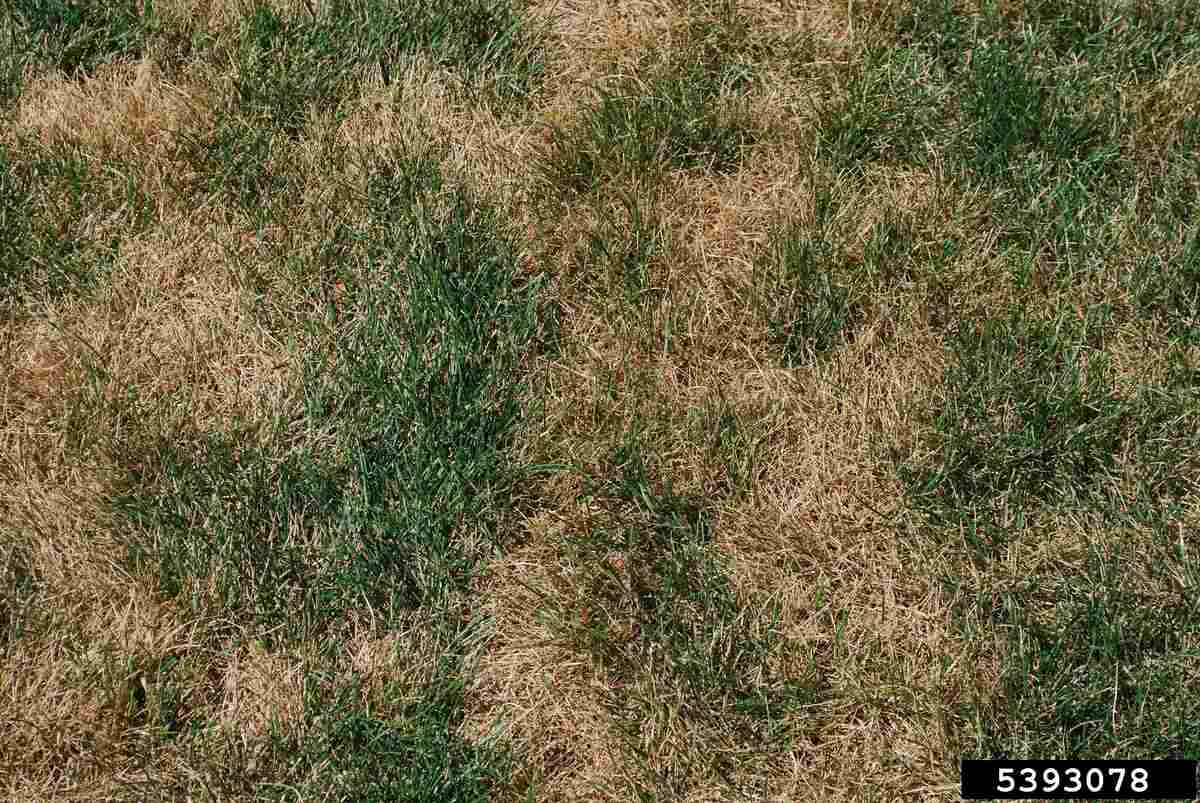
Necrotic ring spot (NRS) is a soil-borne lawn fungus that primarily targets the root systems of grass and cannot be fought solely with fungicides. Luckily, this article will tell you everything about how to treat this disease, from sound lawn care practices to choosing resistant grasses.
NRS is caused by Ophiosphaerella korrae, which loves the cool and moist weather and attacks the turf in spring and fall, forming doughnut-shaped rings of tan grass. The most vulnerable grass type is Kentucky bluegrass. Your best strategy is strengthening your turf by keeping the soil sunny, loose, fertile, adequately watered, and overseeding with resistant species.
Read on to learn more about what puts your lawn at risk for NRS, how to identify and treat the disease, and how to keep it from returning.
How to Identify Necrotic Ring Spot
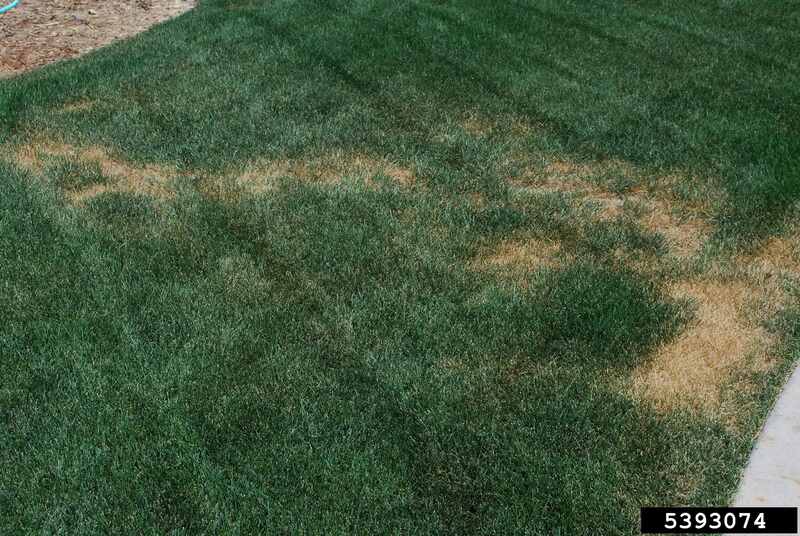
At first, symptoms can be easily confused with heat or drought stress, but as the disease evolves, it gets clearer and clearer that you’re dealing with something else.
Assume a necrotic ring spot infection in your lawn if you see:
- Rings of straw-colored turf with green grass in the middle
- Black rot on the grass roots, crown, or lower stems.
But don’t close the case just yet. Another suspect fits this M.O. — summer patch disease (SPD). It also rots the roots of cool-season grasses and leaves the same ring-like marks on the lawn.
Because their symptoms are so similar, you need a microscope to distinguish between the two diseases. Before starting any treatment, take a grass sample and send it to a turf diagnostics laboratory in your area for testing.
To catch an NRS infection early, at the first signs of grass trouble, check the following:
Overground and Underground Symptoms of Necrotic Ring Spot
The most common signs to look for are:
- Light green patches in the lawn in late spring and fall are how the disease starts. If you battled NRS last year, watch out for this sign like a hawk.
- Reddish-brown, bronze to tan doughnut, or frog-eye-shaped patches with healthy green grass in the middle. These rings of wilted or dead grass start a few inches wide and grow to a few feet across, getting larger each year. They often appear sunken.
- Brown or black rot on the roots, crowns, and sometimes the lower stems of damaged grass. Under the microscope, lab experts see fungal hyphae or mycelium (the fungal vegetative growth that spreads the infection) on necrotic areas.
Less common symptoms that can appear:
- A reddish-brown border develops between the damaged and healthy plants.
- Diseased patches from previous years turn into bright yellow rings.
What’s not there, but it matters to distinguish the NRS from other diseases:
- No individual lesions on the leaves. They wilt and die because of the root damage.
- No airborne spores or white mycelium on the leaves or soil surface. The necrotic ring spot fungus is dark and soilborne. It lives and spreads through the ground.
Lawn Care Problems Favoring Necrotic Ring Spot
Necrotic ring spot is a root disease favored by high moisture and mild temperatures. It often appears in turfs affected by:
- Overwatering. Soil that is continuously moist is excellent for fungal development.
- Shallow watering. Irrigating often and in small amounts keeps roots short and close to the surface and the topsoil moist for longer periods.
- Low spots that collect rainfall. Such areas make a moist and comfortable bed for fungi.
- Areas shaded by trees or buildings, with limited airflow, sun exposure, and slow water evaporation.
- Spots with poor drainage that are exposed to waterlogging.
- Close mowing. Short leaves promote the growth of short roots and are more exposed to grass root diseases.
- Soil compaction. Lack of oxygen and nutrients and a tight soil to dig through keep roots thin, small, and weak.
- Thick thatch and fallen leaves buildup provide excellent breeding grounds and dormancy shelters for fungi and pests.
- Excess nitrogen in the soil. Nitrogen supports foliage growth at the expense of roots. Adding too much in the spring exposes the grass to root diseases and drought stress.
- A deficit in plant-available phosphorus. Phosphorus is essential for root development. It rarely lacks in the soil, but often, it’s in a form not available to plants.
- Root pests. Lawn pests like chinch bugs and grubs damage grass roots, making them more vulnerable to lawn diseases.
Peak Seasons for NRS
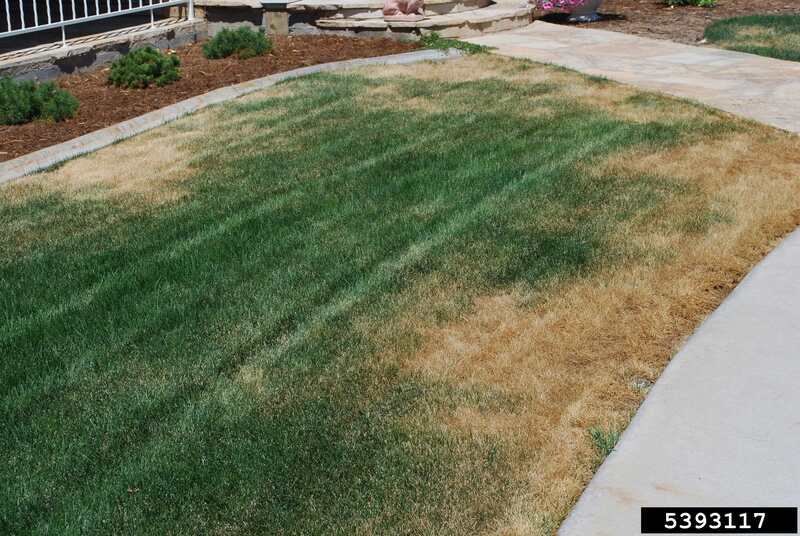
NRS is a mild and wet weather disease that infects grass plants in late spring and fall. The necrotic ring fungus thrives and spreads the most between 68 and 82 degrees Fahrenheit.
When summer temperatures rise above 86 degrees Fahrenheit, O. korrae enters dormancy. The disease no longer spreads, but lawn symptoms intensify quickly due to the heat and drought. Grass already infected cannot withstand the additional stress, and more of it wilts and dies.
In the fall, the fungus becomes active again and starts spreading and damaging the lawn. It goes dormant during winter, only to begin another season in the spring.
Grasses Susceptible to NRS
Necrotic ring spot is mainly a cool-season grass disease common in northern lawns. Kentucky bluegrass is the most affected, but other winter grasses are also vulnerable, such as:
- Annual bluegrass
- Rough bluegrass
- Fine fescues
- Creeping bentgrass
NRS typically occurs 2 to 3 years after the turf is established or later. It is also more common in sodded lawns.
In the South, the Ophiosphaerella family causes another nasty disease — spring dead spot, which severely affects Bermudagrass lawns.
How to Get Rid of Necrotic Ring Spot Disease
Necrotic ring spot disease is a root infection in mild weather and high humidity. To eliminate it, use proper cultural practices to keep the grass healthy and prevent moisture buildup in the lawn. Here are the main curative actions to get rid of NRS:
Aerate and Dethatch the Lawn
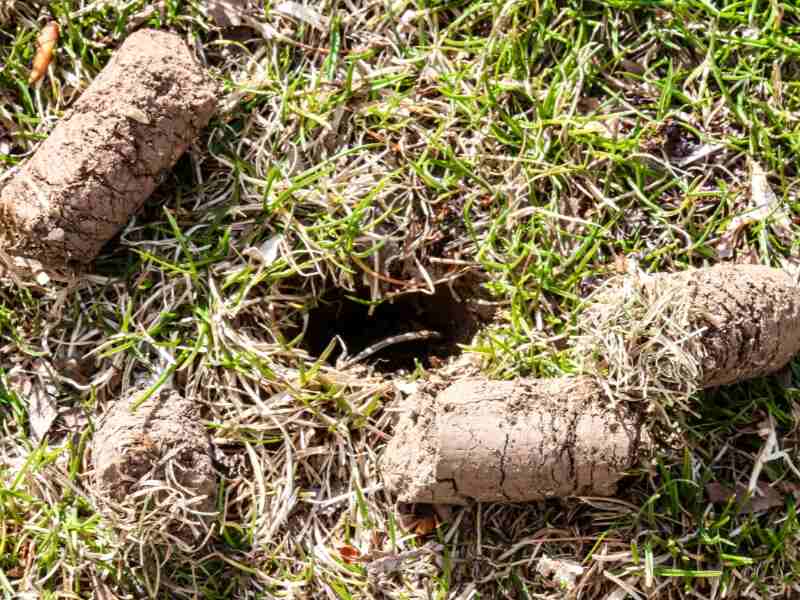
Core aeration loosens compacted soil, helping roots feed, breathe, extend, and grow with less effort. It also ruffles the thatch layer, making it easy to remove. Always aerate the infected areas last to avoid spreading the fungi into healthy turf. When you’re done, clean all the lawn care equipment.
Lightly Water the Affected Areas in Hot Afternoons
Michigan State University recommends watering damaged grass daily in the summer between noon and 4:00 P.M. with 0.1 to 0.2 inches of water. Light watering helps infected turf better withstand afternoon heat and reduces grass death.
Apply a Slow-Release Balanced Fertilizer in Spring and Fall
Use a complete fertilizer with potassium, phosphorus, and slow-release nitrogen. Schedule applications in spring and fall, when cool-season grasses are actively growing.
Do not use nitrogen fertilizer during the stress period, from June to August.
Amend the Soil with Sulfur
Colorado State University recommends using sulfur amendments to increase soil acidity and inhibit the necrotic ring pathogen. A typical treatment is applying 1 to 1.5 pounds of elemental sulfur per 1,000 square feet yearly until soil pH drops to 6.0. Lightly water the lawn after application to wash the sulfur off the leaves.
Increase the Mowing Height
Keep the lawn mower blades at 2 1/2 to 3 inches. Taller grass grows deeper roots that can more easily fight the infection. Never cut more than 1/3 of the blade height. This ensures enough photosynthesis surface and fast recovery from cutting.
Blend Perennial Rye in Your Turfgrass
According to Cornell University, mixing perennial ryegrass with bluegrass can prevent NRS. Use 10 to 15 percent ryegrass (by weight) in your bluegrass seed material when installing a new lawn. You can also use ryegrass to overseed existing turf. Tall fescue is another good alternative.
Overseed with Resistant Bluegrass Varieties
Another option is to overseed with varieties of Kentucky bluegrass that are less susceptible to necrotic ring spot disease, such as:
- Abbey
- Adelphi
- Award
- Baron
- Beyond
- Blue-tastic
- Brooklawn
- Cabernet
- Eagleton
- Eclipse
- Midnight
- Majestic
- Monte Carlo
- Unique
- Voyager
- Wabash
Get a Professional to Apply Preventive Fungicides
Schedule preventive fungicide applications in spring when the soil reaches 65 degrees Fahrenheit. This is when NRS fungi become active but have yet to colonize the roots and crowns.
Water the lawn after application to lead the solution into the ground at the root level. Depending on the severity of the infection, up to three applications might be necessary, 30 to 60 days apart.
The best fungicides used to control necrotic ring spot use the following as active ingredients:
- Fenarimol
- Iprodione
- Myclobutanil
- Propiconazole
- Thiophanate methyl
- A mix of azoxystrobin and propiconazole.
A few commercially available brands commonly used on lawns with NRS are:
- Scotts DiseaseEx Lawn Fungicide (azoxystrobin)
- Headway G Fungicide (azoxystrobin +propiconazole)
- Eagle 20EW Specialty Fungicide (myclobutanil)
Most of the top fungicides used against NRS, like Rubigan (fenarimol), are costly or accessible only to licensed professionals. If your turf needs chemical control, it’s easier to hire a pro to bring our lawn back to health.
How to Prevent Necrotic Ring Spot
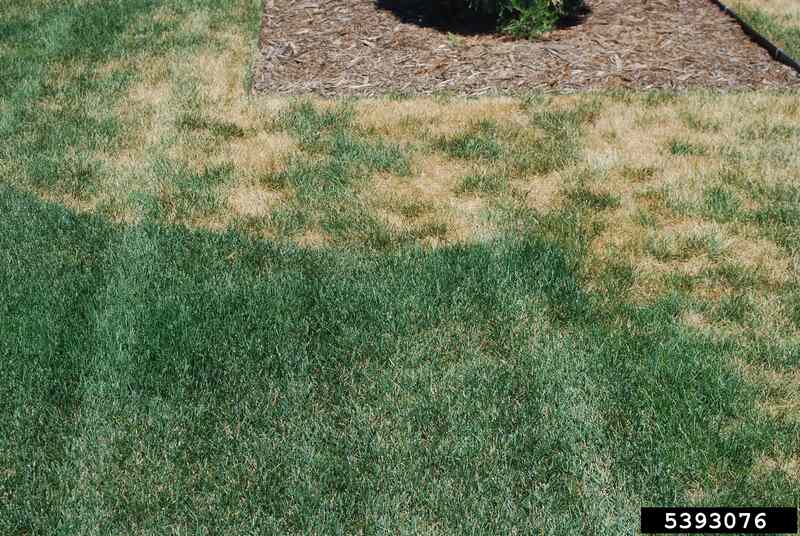
As the doctor says, prevention is better than cure. The best approach for homeowners is to keep a healthy lawn and strong grass and never give the infection a chance. Here are the most critical turf care strategies to remember for a fungi-free lawn:
Choose a grass that will thrive in your lawn. If trees and buildings surround the yard, go for shade-tolerant varieties. Pick up grasses that can tolerate your soil type and conditions the best (clay, sandy, rocky, salty, etc.). Install cool-season grasses if you live up north, warm-season species in the south, and a proper mix in the transition zone.
Clean the lawn periodically. Consider the cost of a yard cleanup. Buildups prevent air circulation and keep the soil and grass shaded and moist.
Plant grasses and grass varieties that are resistant to NRS. The best options are perennial ryegrass and tall fescue. If your heart is set on the Kentucky bluegrass look, choose some of the cultivars that are more resilient to NRS.
Keep the soil aerated. Compacted soil cramps up roots and prevents them from growing. It also limits root access to water, air, and nutrients and is often exposed to puddling and waterlogging. Core aerate at least once a year for loose, well-drained soil.
Use compost to improve soil structure. Compost is an excellent soil amendment, rich in nutrients and organic matter. Apply 2 to 3 inches as a lawn top dressing every year. It improves the soil texture and drainage abilities while balancing nutrients and pH.
Dethatch once a year. When thatch is more than 1/2 thick, it becomes a problem. It traps moisture, limits airflow and sunlight, and smoothers grass plants, impeding their growth. Use a lawn dethatcher at least once a year to ensure proper airflow and water absorption.
Learn to water the lawn according to your climate, season, and type of grass. Most turfgrass requires 1 to 1/2 inches of water a week, including rainfall. Water deeply (moisten the soil 6 to 8 inches deep) and less often. This approach helps your grass dig long, robust roots deeper into the soil.
Check your irrigation system to avoid overwatering and dry spots. Ensure all sprinkler heads are working properly and the lawn is watered uniformly across the entire surface. Adjust watering by sun exposure to prevent moisture from building up in shaded areas.
Fertilize based upon turfgrass needs. Some grasses need less nitrogen than others. Figure out the ideal yearly amount for your seed variety. Use slow-release fertilizer, limit applications to the growing season, and spread no more than 1 pound per 1,000 square feet in one session.
Test the soil. Nutrient and pH imbalances prevent grass from growing healthy and strong. Take a soil test yearly, and use good-quality soil amendments to correct any problems.
Follow a sound weed control schedule. Learn to identify the weeds in your lawn and hand-pull them while young whenever possible. Use effective pre- and post-emergent herbicides that don’t hurt the turfgrass.
Don’t let pests make a home in your yard. Lawn pests like chinch bugs, grubs, and armyworms go for the grass roots, leaving the turf more vulnerable to diseases. Leaf-eaters are no less dangerous.
Other Fungal Diseases That Can Affect Your Cool-Season Grass Lawn
The necrotic ring spot is not the only lawn disease to threaten the health of cool-season turf. With Kentucky bluegrass, tall fescue, fine fescues, or perennial rye on your lawn, you’ll also need to keep an eye for:
- Dollar spot
- Red thread
- Brown patch
- Yellow patch
- Pythium blight
- Fairy ring
- Powdery mildew
- Summer patch
- Leaf rust
- Leaf spot and melting out
- Leaf blight
- Gray and pink snow mold
- Anthracnose
FAQ About Necrotic Ring Spot Disease
What Does a Plant Showing Necrosis Look Like?
Where a plant develops necrosis, the cells die and take a brown or black appearance. Often, you’ll also notice a rotten smell. When it happens at the root or crown level, the rest of the plant wilts and dies because it can no longer absorb water.
What is the Best Fungicide for Necrotic Ring Spot Disease?
Products with active ingredients like fenarimol, propiconazole, myclobutanil, and tiophanate methyl are the most effective in treating necrotic ring spot infection in lawns. Some common brands that use them are Rubigan, Cleary 3336, and BannerMax.
What Grass is Resistant to the Necrotic Ring Spot?
Tall fescue and perennial ryegrass are two grasses resistant to the necrotic ring spot that you can mix with Kentucky bluegrass. They look alike and make for beautiful, resilient lawns.
When to Call a Professional
Necrotic ring spot, with its potential to target and damage the root system of your grass, is a serious concern for any lawn enthusiast. It’s not a challenge to be taken lightly, as it can lead to significant grass damage.
You need a good lawn care plan in place and a professional to apply the best fungicides if necessary. Stay a step ahead of the fungi! Contact our lawn treatment pros through the LawnStarter web platform or mobile app and get rid of the necrotic ring spot today!
Main Photo Credit: Howard F. Schwartz / Colorado State University / Bugwood.org